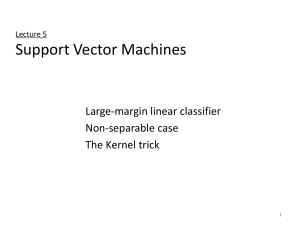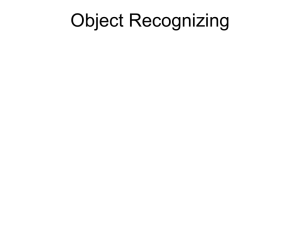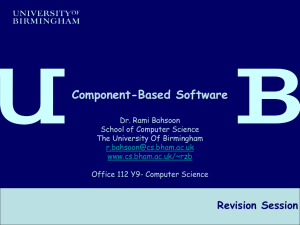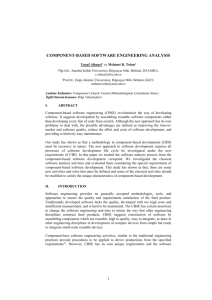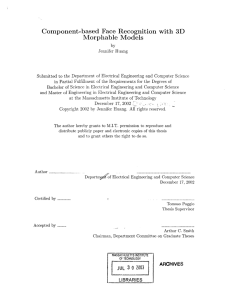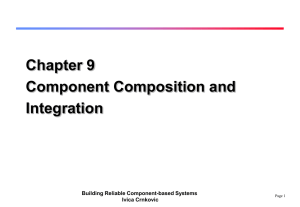Face recognition: component-based versus global approaches
advertisement
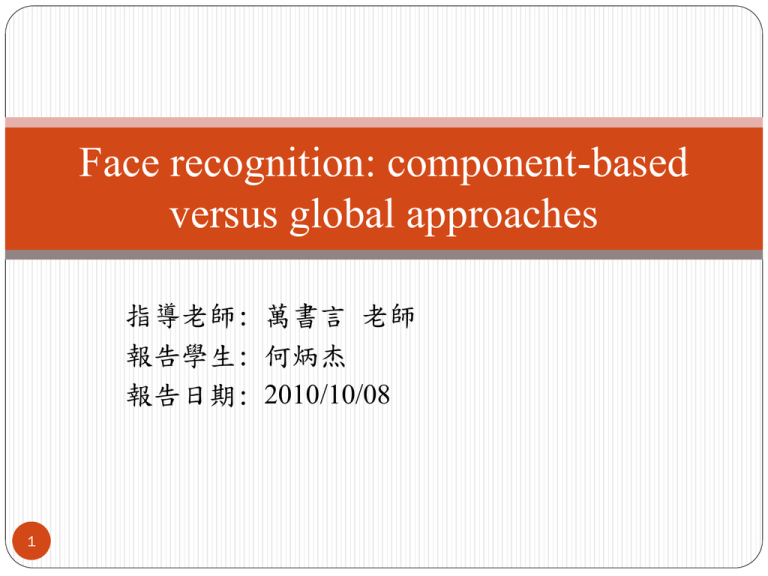
Face recognition: component-based
versus global approaches
指導老師: 萬書言 老師
報告學生: 何炳杰
報告日期: 2010/10/08
1
論文出處
Computer Vision and Image Understanding Volume 91, Issues 1-2, July-
August 2003, Pages 6-21 Special Issue on Face Recognition
Authors :
Honda Research Institute US, 145 Tremont St., Boston, MA 02111, USA
Center for Biological and Computational Learning, M.I.T., Cambridge, MA, USA
Hewlett-Packard, Cambridge, MA, USA
Received 15 February 2002; accepted 11 February 2003. ; Available online
17 July 2003.
2
Abstract
在這篇文章中,作者分別呈現局部(component-
based method)與整臉(global method)方式的人臉辨
識,並評估這兩種呈現方式的系統的穩定性(針對
人臉的位置轉動部分)。
Component
system:
1
Locate facial
components.
2
3
Extract them.
Combine them into a
single feature vector.
The 1st Sys.
Train a single SVM classifier for each person in
the database.
The 2nd Sys.
Consists of sets of view-specific SVM classifier
and involves clustering during training.
The two global
system:
3
1. Introduction
(i) global approach
(ii) component-based approach
(I) Global Approach:
4
Focusing on
the aspect of
pose
invariance.
Global Approach
References
Minimum distance classification
[2,3]
Fisher’s discriminant analysis
[4]
Neural networks
[5]
Fisher’s discriminant analysis && Kernel
PCA
[6, 7]
1. Introduction - Global approach
Global approach 方法的限制:
Global techniques are not robust against pose changes since
global features are highly sensitive to translation and rotation of
the face.
Solutions:
An alignment stage can be added before classifying the face.
Aligning an input face image with a reference frontal face
image requires computing correspondences between the two
face images.
5
1. Introduction - Global approach (cont.)
Solutions:
correspondents: A small number of prominent points in the
face like the center of the eye, the nostrils, or the corners of the
mouth.
center of eye
the nostrils
the corners of the mouth
6
1. Introduction
(II) Component-Based Approach:
7
Component-Based
References
Face recognition: features versus templates
[14]
Face recognition under varying pose
[15]
Face recognition by elastic bunch graph
matching
[16]
An embedded hmm-based approach for face
detection and recognition
[17]
Recognizing imprecisely localized, partially
occluded, and expression variant faces
from a single sample per class
[18]
1. Introduction - Component-Based Approach
The main idea of component-based recognition is to compensate
for pose changes by allowing a flexible geometrical relation
between the components in the classification stage.
A component-based approach is to classify local facial
components. ( eyes, nose, mouth... )
8
1. Introduction - global methods
We present two global approach and a component-based approach
to face recognition and evaluate their robustness against pose
changes.
The first global method:
A straightforward face detector which extracts the face from an input
image.
The second global method:
Split the images of each person into view-specific clusters.
We then train view-specific SVM classifiers on each single cluster.
9
1. Introduction - component-based methods
The component-based system:
Use a face detector that detects and extracts local components
of the face.
The detector consists of a set of SVM classifiers that locate
learned facial components and a single geometrical classifier
that checks if the configuration of the components matches a
learned geometrical face model.
示意圖:
A set of SVM
image
image
image
10
Face
detector
Training(學習階段)
classifiers.
1. Introduction
The outline of the paper is as follows:
Section 2: Give a brief overview on SVM learning and strategies for
multi-class classification with SVMs.
Section 3: Describe the two global methods for face recognition.
Section 4: It’s about the component-based system.
Section 5: Contain experimental results and a comparison between
the global and component systems.
Section 6: Concludes the paper and suggests future work.
11
2.1. Binary classification
SVMs belong to the class of maximum margin classifiers.
They perform pattern recognition between two class by
finding a decision surface that has maximum distance to the
closest points in the training set which are termed support
vectors.
示意圖:
12
出處: C. Cortes, V. Vapnik, Support vector networks, Mach. Learning 20 (1995) 1–25.
2.1. Binary classification - linear classification
OSH(Optimal Separating Hyperplane )
參數部分:
xi n, i 1, 2,..., N
where each xi
points belongs to one of two classes identified the label yi {1,1}.
- xi : A training set of points
- i and b : They are the solutions of a quadratic programming
problem.
- Goal: Separate the two classes by a hyperplane such the distance to
the support vectors is maximized.
13
2.1. Binary classification - linear classification
功用: Perform multi-class classification.
d : The sign of d is the classification result for x , and d is the
x
distance from to the hyperplane.
The larger d , the more reliable the classification result.
14
2.1. Binary classification - non-linear classification
linear
classification
non-linear
classification
k ( x, y ) 的由來:
- Each point x in the input space is mapped to a point
z = (x) of a
higher dimensional space, called the feature space, where the data
are separated by a hyperplane.
- (.) : 由數學中的內積所衍生出的性質。
15
2.1. Binary classification - non-linear classification
-
(.) : It is subject to the condition that the dot product of two points
in the feature space (x)* ( y)。
- Feature space:
f2
. .. .
. .
.
.
.
.
x
f2
f1
. .
. .
. .
z = (x)
f3
f1
- Each point x in the input space is mapped to a point
higher dimensional space, called the feature space.
16
z = (x) of a
2.1. Binary classification - non-linear classification
An important family of kernel functions is the polynomial kernel
- d : The degree of the polynomial.
17
2.2. Multi-class classification
One-vs-all approach(一對多-SVM分類方法)
Pairwise approach(成對的SVM分類方法)
- One-vs-all approach(一對多-SVM分類方法):
. C3
class
1
C1
class
2
18
原則: 取大(取正
號)
class
3
C2
出處: http://www.powercam.cc/slide/6556
2.2. Multi-class classification
Pairwise approach(成對的SVM分類方法)
bottom-up comparison
19
出處: G. Guodong, S. Li, C. Kapluk, Face recognition by support vector machines, in: Proc. IEEE Int.
Conf. on Automatic Face and Gesture Recognition, 2000, pp. 196–201.
2.2. Multi-class classification
Pairwise approach(成對的SVM分類方法)
20
top-down comparison
出處: J. Platt, N. Cristianini, J. Shawe-Taylor, Large margin dags for
multiclass classification, Adv. Neural
Inform. Process. Systems
2.2. Multi-class classification
A more recent comparison between several multi-class
techniques [20] favors the one-vs-all approach because of its
simplicity and excellent classification performance.
出處: R. Rifkin, Everything old is new again: a fresh look at historical approaches in machine learning,
Ph.D. thesis, M.I.T., 2002.
3. Global approach
System process:
image
image
image
Face
detector
Face
Extract the
face from an
input image.
22
Face
recognition
3.1. Face detection - Global approach
In order to detect faces at different scales we first computed a
resolution pyramid for the input image and then shifted a 58*58
window over each image in the pyramid.
※金字塔架構
(pyramid structure)
第四階
( N / 16 ´ N / 16)
第三階
( N / 8 ´ N / 8)
第二階
( N / 4 ´ N / 4)
第一階
( N / 2 ´ N / 2)
第0階
(N ´ N )
原影像
23
出處: http:// www.cs.pu.edu.tw/~ychu/class981/DataComp/15HierarchicalCoding.PPT
3.1. Face detection - Global approach
3.1. Face detection - Global approach
The training data for the face detector was generated by rendering
seven textured 3-D head models [29].
o
o
The heads were rotated between -30 and +30 in depth and
illuminated by ambient light and a single directional light pointing
towards the center of the face.
-30o
25
+30o
出處: A morphable model for synthesis of 3D faces, in: Comput. Graphics Proc.
SIGGRAPH, Los Angeles, 1999, pp. 187–194.
3.1. Face detection - Global approach
Sample size:
- We generated 2457 face images of size 58*58 pixels, some examples
are shown in Fig. 2.
- The negative training set initially consisted of 10,209 58*58
non-face patterns randomly extracted from 502 non-face images.
3.2. Recognition - Global approach
We implemented two global recognition systems.
Both systems were based on the one-vs-all strategy for SVM multi-
class classification described in the previous section.
- The first system:
Use a linear SVM for every person in the database.
Each SVM was trained to distinguish between all images of a single person
( labeled +1 ) and all other images in the training set (labeled -1 ).
. C3
clas
s1
C1
clas
s2
27
clas
s3
C2
3.2. Recognition - Global approach
For both training and testing we first ran the face detector on the
input image to extract the face.
Re-scale:
- We re-scaled the face image to 40*40 pixels and converted the gray
values into a feature vector.
- Given a set of q people and a set of q SVMs, each one associated to
one person, the class label y of a face pattern x is computed as
follows:
3.2. Recognition - Global approach
Formulas:
- di (x) : It is computed according to Eq. (2) for the SVM trained to
recognize person i .
- t : The classification threshold.
- The class label 0 stands for rejection.
3.2. Recognition - Global approach
潛在的問題與限制:
- Changes in the head pose lead to strong variations in the images of a
person’s face.
- These in-class variations complicate the recognition task.
3.2. Recognition - Global approach
解決方案:
- For this reason, we developed a second method in which we split the
training images of each person into clusters by a divisive cluster
technique .
- The cluster with the highest variance is split into two by a
hyperplane.
- N: The number of faces in the cluster.
3.2. Recognition - Global approach
解決方案:
- The face with the minimum distance to all other faces in the same
cluster is chosen to be the average face of the cluster.
average
face
cluster
average
face
cluster
4. Component-based approach
System process:
image
image
image
Face
detector
Face
Detect facial
components.
33
Face
recognition
4.1. Detection
We implemented a two-level, component-based face detector.
34
4.1. Detection
The 14 facial components used in the detection system are shown in
Fig. 5a, their dimensions are given in Table 1.
The shapes and positions of the components
have been automatically determined from the
training data.
Fig. 5. (a) The 14 components of our face detector.
The centers of the components are marked by a white cross.
35
4.1. Detection
Table 1:
We trained 14 linear SVMs on the component data and applied
them to the whole training set in order to generate the training data
for the geometrical classifier.
36
4.1. Detection
In a final step: We trained the geometrical classifier, which was
again a linear SVM, on the X–Y locations and continuous outputs
of the 14 component classifiers.
37
4.1. Detection
缺點:
- The component-based face detector was computationally more
expensive than the global face detector.
- This was because the combined size of the 14 components was
about 1.12 times the size of the face region used in the global
detector.
- In addition, we had to locate the maxima of the responses of the
component classifiers and compute the output of the geometrical
classifier.
- In average, the component-based detector was about 1.2 times
slower than the global detector.
4.2. Recognition
System process:
- Step 1:
First ran the component-based detector over each image in the
training set.
- Step 2:
Extracted the components.
From the 14 original components we kept 10 for face recognition.
篩選條件:
C1014
- Removing those that either contained few gray value structures
(e.g., cheeks) or strongly overlapped with other components.
39
4.2. Recognition
The 10 selected components are shown in Fig. 5b.
The 10 components that were used for face recognition are shown in (b).
40
4.2. Recognition
Examples of the component-based face detector applied to images of the training
set are shown in Fig. 6.
41
5. Experiments
Training set:
- 10,000 gray face images of 10 subjects from which about 1400 were
frontal views.
- The resolution of the face images ranged:
80*80 ~ 130*130 pixels.
o
( with rotations in azimuth up to about +- 40 )
Testing stage:
- 1154 images of all 10 subjects in the database.
o
- The rotation in depth was again up to about +- 40 .
42
5. Experiments
We trained four different recognition systems on the 10,000 images:
(1) Global system using one linear SVM classifier per person.
(2) Global system using one second-degree polynomial SVM per
person.
(3) Global system with one linear SVM for each cluster.
(4) Component-based approach with one linear SVM classifier per
person.
43
5. Experiments
The ROC curves for the four systems are shown in Fig. 7.
44
5. Experiments
Some examples of misclassifications caused by false detections are
shown in Figs. 8 and 9.
45
6. Conclusion and future work
We presented a component-based technique and two global
techniques for face recognition and evaluated their performance with
respect to robustness against pose changes.
The component-based system:
- It detected and extracted a set of 10 facial components and arranged
them in a single feature vector that was classified by linear SVMs.
Both global systems:
- we detected the whole face, extracted it from the image, and used it
as input to the classifiers.
46
6. Conclusion and future work
In the experiment the component-based system outperformed the
global systems even though we used more powerful classifiers (i.e.,
non-linear instead of linear SVMs) for the global system.
研究限制( the current component-based classifier ):
- The current component-based classifier cannot deal with the full
range of poses (from frontal to profile views).
解決方案:
- It will be necessary to train view-specific component classifiers, e.g.,
two mouth classifiers trained on frontal and profile views,
respectively.
47
Thank You!
48


